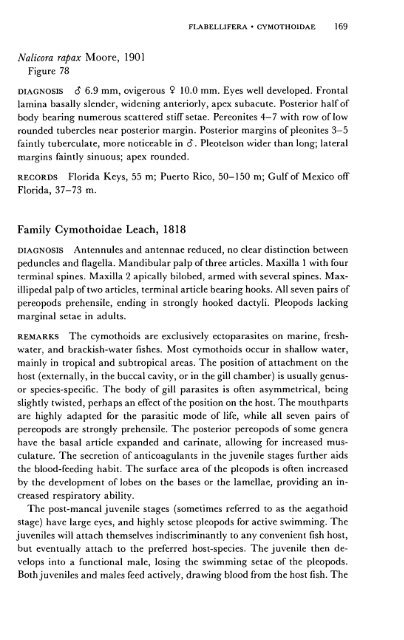Part 2 - Sphaeromatidae::“Cute As Buttons”
Part 2 - Sphaeromatidae::“Cute As Buttons”
Part 2 - Sphaeromatidae::“Cute As Buttons”
You also want an ePaper? Increase the reach of your titles
YUMPU automatically turns print PDFs into web optimized ePapers that Google loves.
Nalicora rapax Moore, 1901<br />
Figure 78<br />
FLABELL1FERA • CYMOTHOIDAE 169<br />
DIAGNOSIS 6 6.9 mm, ovigerous 9 10.0 mm. Eyes well developed. Frontal<br />
lamina basally slender, widening anteriorly, apex subacute. Posterior half of<br />
body bearing numerous scattered stiff setae. Pereonites 4-7 with row of low<br />
rounded tubercles near posterior margin. Posterior margins of pleonites 3—5<br />
faintly tuberculate, more noticeable in 6. Pleotelson wider than long; lateral<br />
margins faintly sinuous; apex rounded.<br />
RECORDS Florida Keys, 55 m; Puerto Rico, 50-150 m; Gulf of Mexico off<br />
Florida, 37-73 m.<br />
Family Cymothoidae Leach, 1818<br />
DIAGNOSIS Antennules and antennae reduced, no clear distinction between<br />
peduncles and flagella. Mandibular palp of three articles. Maxilla 1 with four<br />
terminal spines. Maxilla 2 apically bilobed, armed with several spines. Max-<br />
illipedal palp of two articles, terminal article bearing hooks. All seven pairs of<br />
pereopods prehensile, ending in strongly hooked dactyli. Pleopods lacking<br />
marginal setae in adults.<br />
REMARKS The cymothoids are exclusively ectoparasites on marine, fresh<br />
water, and brackish-water fishes. Most cymothoids occur in shallow water,<br />
mainly in tropical and subtropical areas. The position of attachment on the<br />
host (externally, in the buccal cavity, or in the gill chamber) is usually genus-<br />
or species-specific. The body of gill parasites is often asymmetrical, being<br />
slightly twisted, perhaps an effect of the position on the host. The mouthparts<br />
are highly adapted for the parasitic mode of life, while all seven pairs of<br />
pereopods are strongly prehensile. The posterior pereopods of some genera<br />
have the basal article expanded and carinate, allowing for increased mus<br />
culature. The secretion of anticoagulants in the juvenile stages further aids<br />
the blood-feeding habit. The surface area of the pleopods is often increased<br />
by the development of lobes on the bases or the lamellae, providing an in<br />
creased respiratory ability.<br />
The post-mancal juvenile stages (sometimes referred to as the aegathoid<br />
stage) have large eyes, and highly setose pleopods for active swimming. The<br />
juveniles will attach themselves indiscriminantly to any convenient fish host,<br />
but eventually attach to the preferred host-species. The juvenile then de<br />
velops into a functional male, losing the swimming setae of the pleopods.<br />
Both juveniles and males feed actively, drawing blood from the host fish. The
















